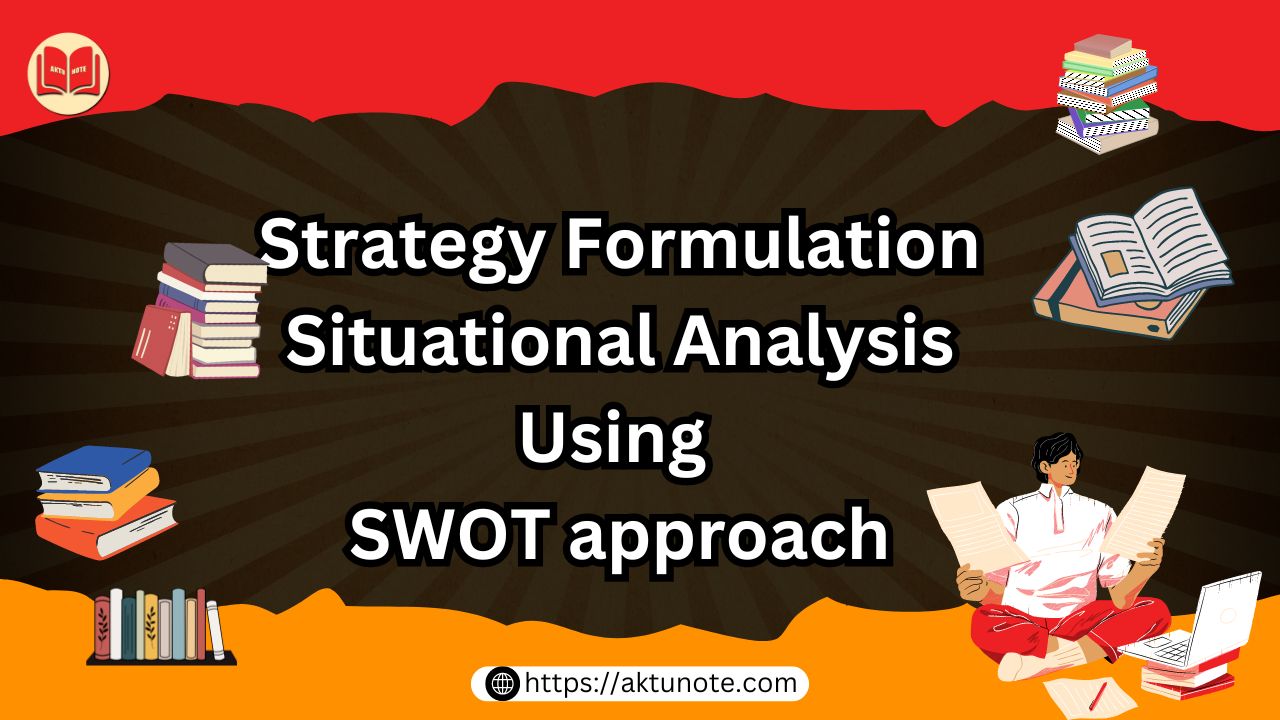Imagine you’re gearing up for a big family reunion, and you want everything to be perfect. To make sure it all goes off without a hitch, you’d first take stock of what you have and what you’re up against. You’d check out the family’s strengths—who’s great at cooking, who can handle the grill, and who’s got the best party games. You’d also think about weaknesses, like that one cousin who always shows up late. Then, you’d consider the opportunities, like a new park that just opened up nearby, and the threats, such as unpredictable weather. This kind of strategic thinking is akin to a business using the SWOT approach for situational analysis.
Strategy formulation is a critical process that determines the long-term direction of an organization. It involves defining the organization’s vision, setting objectives, and developing a plan to achieve those objectives while navigating the competitive landscape. One of the most widely used tools in the strategy formulation process is the SWOT analysis. SWOT, which stands for Strengths, Weaknesses, Opportunities, and Threats, provides a structured framework for analyzing an organization’s internal and external environments. This article explores the role of SWOT analysis in strategy formulation, detailing its components and how it can be effectively used to guide strategic decisions.
What is SWOT Analysis?
SWOT stands for Strengths, Weaknesses, Opportunities, and Threats. It’s a straightforward yet powerful method for evaluating a company’s strategic position. Think of it as your strategic playbook, helping you map out what you’re good at, where you might stumble, what’s up for grabs, and what could stand in your way.
Key Components of SWOT Analysis
SWOT analysis is a situational analysis tool that helps organizations identify their internal strengths and weaknesses, as well as external opportunities and threats. By conducting a SWOT analysis, companies can gain a comprehensive understanding of their current position and the factors that could impact their future success.
1. Strengths
Strengths are internal attributes and resources that support a company’s ability to achieve its objectives. They are what you’re good at and what gives you an edge. For a family reunion, it might be having a fantastic chef in the family or a spacious backyard. In business, it could be a strong brand reputation, proprietary technology, or skilled employees.
Strengths are the internal attributes and resources that give the organization a competitive advantage. These may include:
Core Competencies
Unique capabilities that allow the firm to deliver superior value to customers.
Strong Brand Reputation
A well-established brand that attracts and retains customers.
Skilled Workforce
A highly trained and motivated workforce that drives productivity and innovation.
Financial Resources
Strong financial health, which enables investment in growth opportunities.
Identifying strengths allows organizations to leverage these assets in strategy formulation, ensuring that they are used to maximize competitive advantage.
How to Identify Strengths
- Evaluate internal capabilities and resources.
- Analyze what the company does well compared to competitors.
- Consider unique assets or advantages that differentiate the company.
2. Weaknesses
Weaknesses are internal factors that could hinder a company’s performance. These are areas where you might fall short or need improvement. At your family reunion, it might be a lack of a sound system for music or a shortage of seating. In a business context, it might involve outdated technology, a limited market presence, or gaps in skills.
Weaknesses are internal factors that may hinder the organization’s ability to achieve its objectives. These could include:
Operational Inefficiencies
Processes that are not optimized, leading to higher costs or slower production times.
Limited Market Presence
A lack of market penetration or brand recognition in key markets.
Outdated Technology
Reliance on obsolete technology that reduces competitiveness.
Weak Financial Position
Insufficient capital or poor cash flow management that limits strategic flexibility.
Acknowledging weaknesses is crucial for developing strategies that address and mitigate these limitations, thereby strengthening the organization’s overall position.
How to Identify Weaknesses
- Assess areas where the company struggles or lacks resources.
- Identify factors that put the company at a disadvantage.
- Review feedback from customers or employees for insights into problem areas.
3. Opportunities
Opportunities are external factors that the company can capitalize on to grow and improve. They are the chances you can take advantage of to boost your success. For your reunion, it might be a new community event space that’s available or a chance to collaborate with a local vendor for catering. In business, it could be emerging market trends, technological advancements, or changes in consumer preferences.
Opportunities are external factors that the organization can exploit to achieve its goals. These may include:
Market Growth
Emerging markets or expanding demand within existing markets that offer potential for growth.
Technological Advancements
Innovations that can be adopted to improve products, services, or processes.
Regulatory Changes
New regulations that create favorable conditions or reduce barriers to entry.
Shifts in Consumer Preferences
Changing consumer behaviors that align with the organization’s offerings.
Identifying opportunities allows organizations to align their strategies with external conditions, taking advantage of favorable trends or developments in the market.
How to Identify Opportunities
- Scan the external environment for emerging trends and changes.
- Look for gaps in the market or areas of potential growth.
- Analyze competitor activities to find areas where you can gain an advantage.
4. Threats
Threats are external challenges that could impact the company’s performance negatively. They are the obstacles or risks that could derail your plans. At your reunion, it might be unpredictable weather that could ruin outdoor plans or a local event that draws your guests away. In business, threats might include economic downturns, increasing competition, or regulatory changes.
Threats are external factors that could pose challenges or risks to the organization’s success. These could include:
Intensified Competition
Increased competition from existing rivals or new entrants that erode market share.
Economic Downturns
Economic recessions or fluctuations that reduce consumer spending and profitability.
Technological Disruptions
New technologies that render existing products or services obsolete.
Regulatory Constraints
New laws or regulations that increase operational costs or limit market access.
Recognizing threats is essential for developing strategies that protect the organization from potential risks and ensure its long-term viability.
How to Identify Threats
- Monitor external factors that could affect the company negatively.
- Evaluate potential risks and their impact on the business.
- Consider how changes in the industry or market might pose challenges.
Applying SWOT Analysis in Strategy Formulation
Once the SWOT analysis is conducted, the insights gained can be used to inform the strategy formulation process. The following steps outline how SWOT analysis can be integrated into strategic planning:
Matching Strengths with Opportunities
One of the primary goals of strategy formulation is to match the organization’s strengths with external opportunities. This involves identifying areas where the company’s unique capabilities can be leveraged to capitalize on market trends or fill gaps in the market. For example, a company with a strong brand and innovative product line may focus on expanding into emerging markets where demand for its products is growing.
Converting Weaknesses into Strengths
To build a robust strategy, organizations must address their internal weaknesses. This may involve investing in new technologies, improving operational processes, or enhancing employee training. By converting weaknesses into strengths, the organization can strengthen its competitive position and improve its ability to execute its strategic plans.
Mitigating Threats
Strategies must also account for external threats that could undermine the organization’s success. This might involve developing contingency plans, diversifying product lines, or building strategic alliances to share risks. For example, a company facing intense competition might focus on differentiating its offerings or improving customer loyalty to mitigate the impact of competitive pressures.
Developing Strategic Options
Based on the SWOT analysis, organizations can develop a range of strategic options. These options may include growth strategies such as market penetration, market development, product development, and diversification. Alternatively, the organization might consider defensive strategies such as cost reduction, divestment, or restructuring to protect its market position.
Prioritizing Strategic Initiatives
Not all strategies are equally viable or necessary, so organizations must prioritize their strategic initiatives. This involves evaluating the feasibility, potential impact, and alignment with organizational goals of each strategic option. By prioritizing initiatives that offer the greatest potential for success, organizations can focus their resources on the most promising opportunities.
Implementing and Monitoring the Strategy
The final step in the strategy formulation process is to implement the chosen strategies and monitor their progress. This requires setting clear objectives, assigning responsibilities, and establishing performance metrics. Regular monitoring allows the organization to assess the effectiveness of its strategies and make adjustments as needed to respond to changing conditions.
For More Content Check Out :- KMBN 301
Conclusion
SWOT Analysis is a valuable and essential tool for businesses to assess their strategic position and formulate effective strategies by examining internal strengths and weaknesses, as well as external opportunities and threats. Much like planning a family reunion where you identify what’s working well, what needs improvement, what new possibilities exist, and what obstacles might arise, SWOT analysis helps companies leverage their assets, address challenges, and seize new opportunities. By providing a structured approach to understanding the internal and external factors that impact an organization’s ability to achieve its objectives, SWOT analysis guides strategic decision-making, enhances competitive advantage, and aligns strategies with market conditions, ultimately contributing to the long-term success of the organization.

